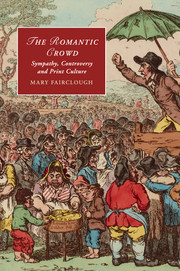The Romantic Crowd
In the long eighteenth century, sympathy was understood not just as an emotional bond, but also as a physiological force, through which disruption in one part of the body produces instantaneous disruption in another. Building on this theory, Romantic writers explored sympathy as a disruptive social phenomenon, which functioned to spread disorder between individuals and even across nations like a 'contagion'. It thus accounted for the instinctive behaviour of people swept up in a crowd. During this era sympathy assumed a controversial political significance, as it came to be associated with both riotous political protest and the diffusion of information through the press. Mary Fairclough reads Edmund Burke, Mary Wollstonecraft, William Godwin, John Thelwall, William Hazlitt and Thomas De Quincey alongside contemporary political, medical and philosophical discourse. Many of their central questions about crowd behaviour still remain to be answered by the modern discourse of collective psychology.
- Examines Romantic period accounts of crowds, challenging the traditional view of the solitary Romantic artist
- Demonstrates how Romantic period debates are still relevant to modern disciplines such as collective psychology
- Literary and non-literary material is considered side by side; authors discussed include Burke, Wollstonecraft, Godwin, Hazlitt and De Quincey
Product details
October 2015Paperback
9781107566668
312 pages
230 × 152 × 16 mm
0.44kg
7 b/w illus.
Available
Table of Contents
- Introduction: collective sympathy
- Part I. Sympathetic Communication, 1750–1800: From Moral Philosophy to Revolutionary Crowds:
- 1. Sympathy and the crowd: eighteenth-century contexts
- 2. Sympathetic communication and the French Revolution
- Part II. Romantic Afterlives, 1800–50: Sympathetic Communication, Mass Protest and Print Culture:
- 3. Sympathy and the press: mass protest and print culture in Regency England
- 4. 'The contagious sympathy of popular and patriotic emotions': sympathy and loyalism after Waterloo
- Afterword: sympathy and the Romantic crowd
- Select bibliography
- Index.


